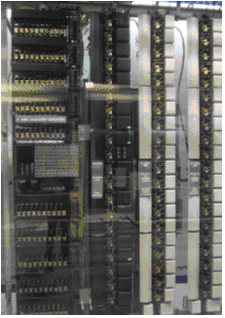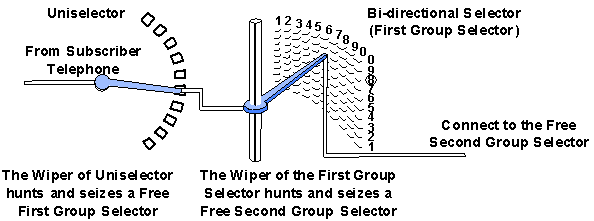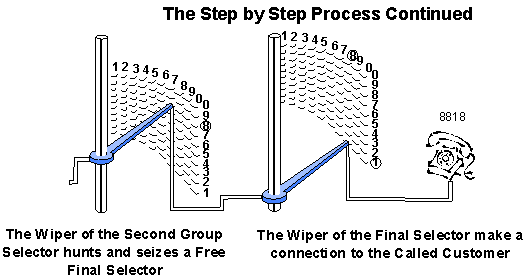The Siemens F1 Telephone Exchange
The Siemens F1 Telephone Exchange that was installed in Macao on 8th December 1929, Figure 1. It is based on the Strowger technology – the type generally known as Step-by-Step, because the interconnection to the Called Number is established Step by Step, as many steps as, the total number of Digits that composes the Called Number, less one. For instance, as can be understood from the following paragraphs, a Telephone Exchange with 5-Digits Customers needs three Group Selectors and one Final Selector, 5 – 1 = 3 + 1.
 Figure 1: Siemens F1 Telephone Exchange
Figure 1: Siemens F1 Telephone Exchange
There are two types of Selectors used in the Strowger technology. As shown in Figure 2, one is called the Uniselector, which has a set of moving contact arms called Wipers. The set of Wipers Rotate (only one movement) over a bank of fixed contacts arranged in the form of an arc to seize a Free First Group Selector. The other is called the Bi-directional Selector, (of which the Group Selector and the Final Selector are examples) which has a set of Wipers that move Vertically and Horizontally (two movements) over a bank of contacts. The contacts are arranged Vertically as ten separate levels, one above the other, and Horizontally as ten separated outputs.
 Figure 2: The Wiper of the Uniselector hunts and seizes a Free First Group Selector. Then the Wiper of the First Group Selector steps Vertically (First Dialed Digit) and Rotates to connect to a Free Second Group Selector
Figure 2: The Wiper of the Uniselector hunts and seizes a Free First Group Selector. Then the Wiper of the First Group Selector steps Vertically (First Dialed Digit) and Rotates to connect to a Free Second Group Selector
The Vertical and Horizontal movements of a Group Selector are respectively associated with the dialed Digit and with the Next Free Group Selector. The Vertical and Horizontal movements of a Final Selector are respectively associated with the Second to Last and Last Dialed Digit.
The general arrangement of the Group and Final Selectors, in a typical 4-digit Strowger Exchange, is shown in Figure 2.
- When the Calling Customer lifts the Telephone Handset from the Cradle, the Hook (Spring-operated) Switch in the Telephone closes and an Electrical Circuit is formed between the Telephone and Telephone Exchange. The Exchange receives the Signal that a Customer is ready for a Dial. The set of Wipers of the Uniselector Rotate to seize a Free First Group Selector.
- After a First Group Selector has been founded, it connects the Calling Customer to the "Dial Tone" and then waits for Dialing. During Dialing, the set of Wipers of the First Group Selector step Vertically according to the First Dialed Digit, and Rotates to seize a Free Second Group Selector, Figure 2.
- After a Second Group Selector has been founded, its set of Wipers step Vertically according to the Second Dialed Digit and Rotates to seize a Free Final Selector, Figure 3.
 Figure 3: The Wiper of the Second Group Selector steps Vertically (Second Dialed Digit) and Rotates to connect to a Free Final Selector. Then the Wiper of the Final Selector steps up Vertically (Second to Last Dialed Digit) and Rotates (Last Dialed Digit) to connect to the Called Customer
Figure 3: The Wiper of the Second Group Selector steps Vertically (Second Dialed Digit) and Rotates to connect to a Free Final Selector. Then the Wiper of the Final Selector steps up Vertically (Second to Last Dialed Digit) and Rotates (Last Dialed Digit) to connect to the Called Customer
- The set of Wipers of the Final Selector step Vertically according to the Third Dialed Digit and Rotates according to the Fourth Dialed Digit, Figure 3, and the connection is established.
From the above explanations one can conclude that each Group Selector "absorb" only one Dialed Digit while the Final Selector "absorb" the last two.
BRIEF HISTORY IN MACAO
The Siemens F1 Telephone Exchange came into service on 8th December 1929, and its installation constituted one of the key milestones in Macao Telecommunications History. Being one of the first Automatic Telephone Exchanges installed in Asia, it had a capacity of 2500 lines, with Customer Numbers ranging from 2000 to 4500.
The Siemens F1 was fully operational for more than 50 years, from 1929 until 1983, the year that finally Macao Telecommunication Company (CTM) deactivated it and handed it back to Macao Post (CTT) to be on display in its previous small Museum Room in the CTT headquarters building.
Its long last operation and great services provided to Macao Population throughout half a century are worth mentioning.
Links
About CMM
Contact US
Others
Other Websites
Number of Visitors:
Last Modified Date: 10/3/2025